If you like tasting various Chinese cuisines, you shouldn’t miss the 15 days tastiest China food tour. This tour will begin in Beijing and our Beijing food guide will take you to explore the famous Peking Roast Duck and many other mouth-watering dishes. In Xi’an, you can taste Zeng Gao (rice and jujube cake), Roujiamo (Chinese hamburger), Sour and Spicy Dumplings, and so on. After tasting these delicacies, you will find it difficult to select the best food in Xi’an from them. Then you will have the opportunity to see cute pandas in Chengdu and take a cruise to Yangshuo from Guilin. Shanghai is the last city during the 15-day tour and here you’ll enjoy the skyscrapers and classical garden. During the Shanghai food tour, you will be taken to taste locally preferred food such as spar ribs with rice cakes and Shanghai steamed buns. Don’t hesitate and let’s start a tasting adventure!

In the morning, you will reach Beijing and start your foodie tour in China. Beijing, a booming metropolis, is in the north of China and covers an area of more than 16.4 thousand square kilometers. It has a population of over 21.8 million. In this city with a history of more than 3,000 years, you will not only visit many cultural attractions like the Forbidden City, Ming Tombs, Mutianyu Great Wall, and Temple of Heaven, but also taste various traditional delicacies, such as Peking Roast Duck, mutton hot pot, stewed liver, noodles with soy bean paste. You will be met by our local guide at the arrival hall of the airport and escorted to your downtown hotel by a comfortable vehicle.
After breakfast, your guide will take you to Tian’anmen Square, the first stop in Beijing. With an area of 440,000 square meters, it can hold nearly one million people for a gathering. In the middle of the square stands the Monument to the People’s Heroes. The 37.94-meter-tall monument contains about 17,000 pieces of marble and granite. It is built to commemorate martyrs who died for revolutionary struggles during the 19th and 20th centuries. In the front of the monument is an inscription in Mao Zedong’s handwriting, which means, “Eternal glory to the people’s heroes!” In the back of the monument is an epitaph, composed by Chairman Mao Zedong and written by Premier Zhou Enlai.
Then we will see the Forbidden City (closed each Monday), also known as the Palace Museum. Surrounded by 10-meter-tall walls, the Forbidden City is a rectangle, measuring 961 meters from north to south and 753 meters from east to west. It was constructed from the year 1406 to 1420, and was the imperial palace where 24 emperors of Ming (1368-1644) and Qing (1644-1912) Dynasties used to live in. When you visit the area of the Palace of Tranquil Longevity, you will see the Nine Dragons Screen built in 1770. It’s made of glazed tiles and nine writhing dragons on the wall are extremely lifelike. However, you can find that there is a dragon with a wooden belly and such a mistake shouldn’t have been in imperial architecture. Why? It’s said that the origin dragon’s belly made of glazed tiles was broken by workers accidentally and it was too late to make a new one. At that time, if workers had failed to finish the project on time, they would have been executed. So the lead worker Ma Dechun took a risk and let the best carpenter carve out a wooden belly and then brushed it with white paint. This flaw wasn’t found during the inspection. As time went by, the white paint slowly peeled off and we can see the wooden belly now.
Then we will continue to visit Jingshan Park, located on the central axis of Beijing. Covering an area of 230,000 square meters, this park is founded on 43-meter-tall Jingshan Hill. During the Ming and Qing Dynasties, numerous fruit trees were planted there and deer, cranes, and other animals were also raised there. Now you can see peony garden, ginkgo garden, begonia garden, peach orchard, apple orchard, and so on in the park. This Park is the biggest peony garden in Beijing and during May each year, with the 20,000 peoniesof some 200 varieties in full bloom, the park displays a wonderful and colorful scene.
After lunch, your guide will take you to Hutong in Shichahai area and visit a family there. Hutong is a typical small alley in Beijing and it has a history of 700 years. Every Hutong has its own story and our guide will tell you some of them if you are interested. We will arrange the rickshaw, the most classic way, for you to explore Hutong. There you can see Siheyuan (quadrangle courtyard), the traditional residence of Beijing. It is surrounded by four houses - a principal house (facing to south mostly), an opposite house, an eastern-wing house, and a western-wing house.
Today your last stop is the Summer Palace, located in the western suburbs of Beijing. Mainly dominated by Longevity Hill and Kunming Lake, it covers an expanse of 2.9 square kilometers. In the Summer Palace, one of the most popular attractions is the Long Corridor built in 1750. The entire corridor is 728 meters long and is the longest in China’s ancient buildings and gardens. It also contains more than 14,000 paintings, including landscapes, flowers, birds, and stories from the Four Great Classical Novels in China (A Dream of Red Mansions, Journey to the West, Romance of the Three Kingdoms, and Water Margin). You cannot even find out two identical paintings. Besides, when it rained or snowed, emperors could enjoy the landscapes of Kunming Lake here. There are many other places worth visiting in the Summer Palace, come and see it with your own eyes!
Optional Activity: Red Theatre is an excellent place for you to know about Chinese Kung Fu where you can watch a magnificent Kung Fu performance: Legend of Kung Fu (19:30-20:50). The actors show different kinds of Chinese Kung Fu, including snake style boxing, monkey style boxing, single whip, and double whip. Irish and Australian audience once said that it is worth visiting Beijing just to watch the Legend of Kung Fu at the Red Theatre.
Peking Roast Duck was a famous dish on the imperial court menu in the past but you can find it in many restaurants now. The restaurant staff will slice the whole duck into more than one hundred pieces with both meat and skin. The meat is often eaten with spring onion, cucumber and sweet bean sauce with pancakes rolled around the fillings. Peking Roast Duck attracts many tourists both home and abroad to have a try.
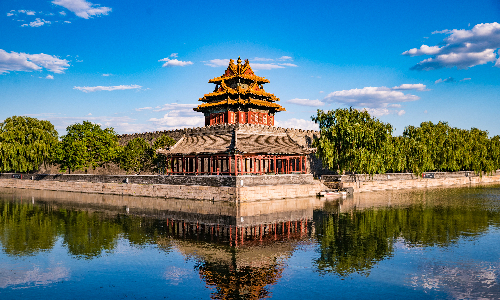
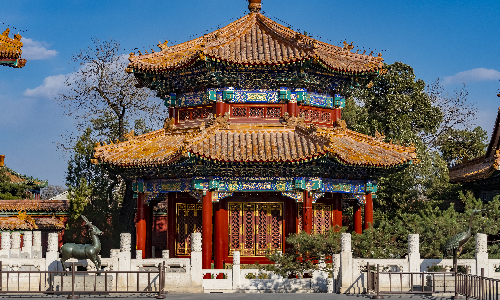
After breakfast, our guide will take you to have a cooking class. It will last for about 2-3 hours. The chef specialized in various traditional Chinese food will teach you how to select fresh ingredients and how to cook some simple Chinese food. You can have what you have just cooked for lunch today. And when you are back home, you can make some Chinese food for your family and friends! I’m sure they will be surprised.
In the afternoon, you will drive north for about 1.5 hours to the Mutianyu Great Wall, 73 kilometers away from Beijing downtown. With a total length of 5,400 meters, it is the longest Great Wall in China. We will take the chairlift up and toboggan down, so your visit will be very easy. But please notice that toboggan is only suitable for people under the age of 60. The Mutianyu Great Wall, a defensive system in the past, has become an important attraction for tourists world wide, including some foreign leaders. The Australian Prime Minister visited the Mutianyu Great Wall in 1985. Since then, more than 100 foreign leaders have visited the Mutianyu Great Wall, including the US President and the Prime minister of the United Kingdom. According to statistics, the number of foreign visitors accounts for more than 50% of the annual tourists to the Mutianyu Great Wall. I believe that you will be interested in this place, too.
Then we will return to the city and you will pass by the Birds’ Nest and the Water Cube. The Birds’ Nest, also called the Beijing National Stadium, was the main stadium for the 2008 Beijing Olympic Games and the Water Cube (Beijing National Aquatics Center) was the main swimming place at that time. You will stop at a place nearby and take some nice pictures of them.
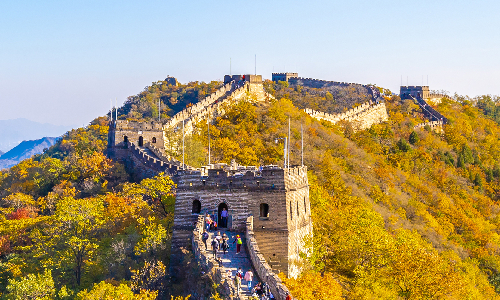
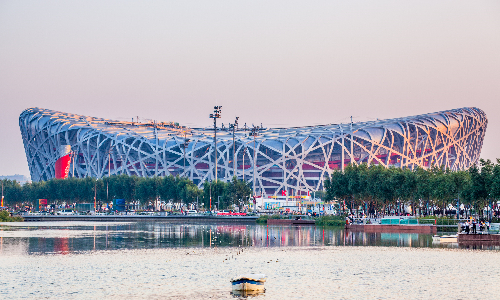
Today you can arrange your time freely to visit Beijing. If you don’t know much about Beijing, here are our suggestions. The first stop we recommended is 798 Art Zone, also known as Dashanzi Art Zone. With an area of over 600,000 square meters, there are galleries, cultural companies, bars, and shops, forming a strong artistic atmosphere. Various exhibitions are held here all year round. At the west gate, you can see a wall full of colorful graffiti and the contents of the graffiti can be words, symbols, graphics, and so on. If you like taking photos, please do not miss this place.
Then you can go to the Silk Street Market and it is an international tourism shopping market as famous as the Great Wall and the Forbidden City. The existing stores in the Silk Street Market sell more than 20 categories of goods, such as clothing, shoes, bags, silk, jewelry, and handicrafts. All of them are favored by consumers all over the world. George Herbert Walker Bush, former Afghan President Hamid Karzai, and many other foreign distinguished guests have come here to purchase goods.
Wangfujing Street, the most famous commercial street in Beijing, is also a nice choice for you. The street is 1,818 meters long and can be divided into four sections. Here you can taste the famous snacks of Beijing, such as soybean cake, Tanghulu (a traditional Chinese snack made of candied fruit), and boiled tripe. In addition to those long-established brands, there are many modern luxury brands like Gucci, Chanel, LV, and Hermes. Come here to enjoy the fun of shopping and delicacies.
You can also visit Houhai Lake, it covers an area of 146.7 hectares. Its street structure was formed in the Yuan Dynasty and now many buildings still keep the typical characteristics of traditional Beijing architecture. Here you can visit the former residences of celebrities and enjoy the snacks. When night falls, this place will turn into a paradise for bar hoppers.
Sanlitun Area situates in the Chaoyang District and there are many bars and shopping malls. It is especially lively at night and a good place to enjoy the night life of Beijing.
If you want to taste all kinds of dishes and snacks in Beijing, we suggest that you go to Huguo Temple Snack Street or Guijie. The Huguo Temple Snack Street is known for low prices and rich varieties. You can find over 80 kinds of snacks there, including Aiwowo (steamed rice cakes with sweet stuffing), pea flour cake, deep-fried dough twists, Douzhir (a fermented bean drink), and so on. The popular dishes of Guijie are grilled fish and spicy crayfish. Because it is near embassies, you can see tourists and foreign staff in Beijing enjoy Chinese food here.

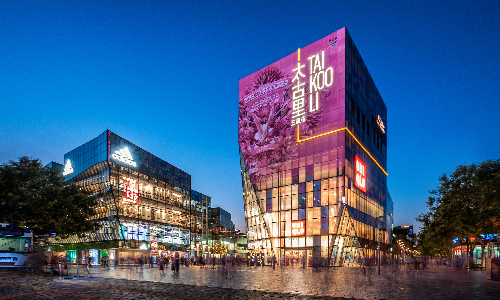
 Xi'an
Xi'an This morning, you will go to the Temple of Heaven, situated in the south of Beijing. It was built in 1420 and emperors worshiped the god and prayed for good harvest here in the Ming and Qing dynasties. There is an interesting place, called Echo Wall, in the Temple of Heaven. The Echo Wall is the wall of the Imperial Vault of Heaven and it is 3.72 meters high. The wall is very smooth and its radian is regular, which is very beneficial to the propagation of sound waves. Speaking to the wall, two people, at a distance of 40 or 50 meters, can hear each other.
After lunch, you will be transferred to the Beijing West Railway Station and then take the estimated train G57 14:00/18:24 to Xi’an. After arrival, our guide will take you to the hotel. Xi’an, also known as Chang’an in ancient times, is the capital of Shaanxi Province and one of the four great ancient capitals of the world. It covers an area of 10,108 square kilometers and has a population of over 12.9 million. In Xi’an, there are a great number of tourist attractions, such as Terra Cotta Warriors and Horses Museum, Great Tang All Day Mall, and Big Wild Goose Pagoda. Also, its traditional delicacies, like Paomo (mutton and bread pieces in soup), Roujiamo (Chinese hamburger), and Zeng Gao (rice and jujube cake), attract many visitors from home and abroad. You are welcome to taste the delicious food.
Free Time Suggestion: Great Tang All Day Mall is a place for you to experience the culture of the Tang Dynasty (618-907) in Xi’an. Great Tang All Day Mall stretches 2,110 meters long and 500 meters wide where it shows the history and culture of the thousand-year-old ancient capital. Apart from enjoying delicious food here, you can watch melodrama and visit some galleries. There is also a 2,100-meter pedestrian street where you can see the statues of emperors, heroes, and other historical figures of the Tang Dynasty.
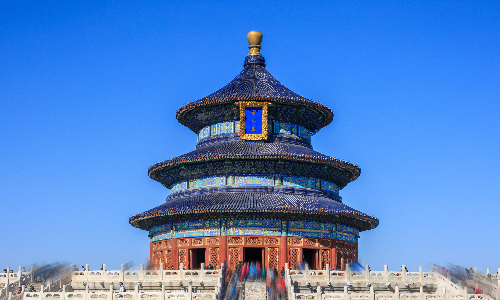

After breakfast, we will drive east for about 40 minutes to the Terra Cotta Warriors and Horses Museum, nearly 43 kilometers away from Xi’an city center. The terra cotta warrior was hailed as the Eighth Wonder of the World. The terra cotta figures are the sacrificial objects of Qin Shihuang (259-210BC), the first emperor of China. He ascended the throne at the age of 13 and later established the first united and centralized country in Chinese history. During his reign, Qin Shihuang took a series of measures to consolidate his power, such as unifying currency, laws, and wordage as well as building the Great Wall.
In the afternoon, you will visit the Big Wild Goose Pagoda, located in the Da Ci’en Temple (a famous Buddhist temple built in 648). The Big Wild Goose Pagoda was built in 652 to preserve the Buddhist scriptures, Buddha statues, and Buddha relics brought by Xuanzang, an eminent monk in the Tang Dynasty. In 629, Xuanzang started the westward journey to India and finally got there after overcoming many difficulties. He spent five years studying Buddhist culture there and traveled the whole country. In 645, Xuanzang returned to Chang’an (the name of Xi’an in ancient times) with Buddha figures, 657 kinds of sutras, and several Buddha relics. Having gotten the permission of Emperor Gaozong (628-683), Xuanzang, as the first abbot of Da Ci’en Temple, supervised the building of a pagoda-the Big Wild Goose Pagoda inside it.
In the afternoon, we will go to the Great Mosque. It covers an area of 13,000 square meters and is one of the two oldest great mosques in Xi’an. The Great Mosque combines a traditional Chinese architectural form with Islamic functionality. Its architecture form is characterized by Chinese national style while its decorations like carvings and patterns are in accordance with the Islamic custom. It’s listed as one of the UNESCO World’s Islamic Culture Relics.
Then you will be taken to the Muslim Quarter which is the center of the Muslim community in Xi’an and is always known for numerous delicious food. Strolling around the street, you can purchase national dress and handicrafts as well as taste local snacks there including Roujiamo, Mutton and Bread Pieces in Soup, Mutton Shashlik, and Liangpi (cold noodles).
Later, you will be transferred to the hotel and have a rest. Your tasting tour in Xi’an is coming to an end and you will leave for the next city tomorrow. I hope the two-day tour in Xi’an would make a deep impression on you.
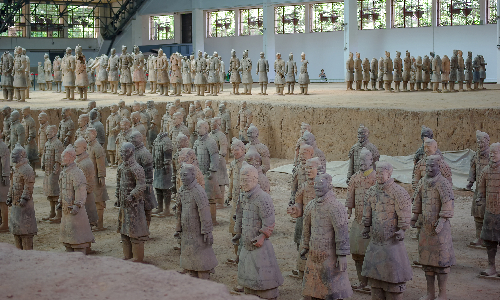
 Chengdu
Chengdu This morning, you will be transferred to the train station and take the estimated high-speed train D1917 09:00/12:17 to Chengdu. You will be picked up by our tour guide at the railway station and escorted to your hotel in Chengdu.
Chengdu is the capital of Sichuan province, which is 14,335 square kilometers in size and has a population of over 20.9 million. As a city with a long history, Chengdu enjoys the reputation of “Land of Abundance” and is popular with tourists from home and abroad. Apart from visiting regular tourist attractions, you will also go to a research base of pandas to see lovely pandas in Chengdu. Here you can also taste Sichuan cuisine, one of the four major cuisines in China, and has a great reputation both at home and abroad. In Chengdu, there are numerous dishes that you can taste, including Mapo Tofu, hot pot, poached spicy pork slices, Kung Pao Chicken, and so on. Let me show you one of the dishes, Kung Pao Chicken. It is made with small pieces of diced chicken, peanuts, and chili peppers. Of course, this dish remains a common sight on Chinese takeout menus but its taste in Chengdu is spicier owing to regional variation. I believe that you can’t wait to taste these delicacies, so come on and join us.
Free Time Suggestion: Kuan Zhai Alley is a commercial pedestrian street in Chengdu where you can taste local snacks such as meat dumplings in spicy sauce, spicy rabbit meat, sticky rice dumplings, and Dan Dan noodles (spicy Sichuan noodles).
This morning, we will visit the Chengdu Research Base of Giant Panda Breeding where you can get close to the cute pandas. You might have seen pandas on television but do you know why pandas are black and white? According to the legend, pandas were originally white. Once, four young shepherdesses were killed when trying to save a giant panda from a hungry leopard. When the other pandas heard about this, they decided to hold a funeral in memory of the four girls. To show their respect, the pandas wore black armbands for the funeral. At the funeral, the pandas were so sad and they cried hard. Their tears mixed with the black dye of armbands and dripped down, dying parts of their bodies black. The pandas kept the black spots as a memorial of the four girls, so they are black and white since then.
Then our guide will take you to have lunch. You will have the world-famous Sichuan hot pot. In the hot pot restaurant, you will see people sit around a boiling pot of spicy soup and cook their favorite vegetables as well as meat in it. Beef tripe and other animal offal are preferred by local people but if you don’t like these, you can choose from various vegetables, seafood, mushrooms, and meat. In order to meet the needs of different diners, many restaurants provide two-flavor hot pot and you can cook food in either a plain broth or a spicy one.
After lunch, we will go to People’s Park. Built in 1911, the park covers an area of 112,639 square meters. Our guide will take you to the Heming Tea House, a well-known tea house in the park. With a history of nearly 100 years, it is one of the oldest tea houses in China. The tea house always remains a leisurely lifestyle and uses the old-fashioned bamboo chairs, tables, and teapots made of copper.
Then you will visit the Wuhou Temple. The temple covers an area of 150,000 square meters and was originally built to commemorate Zhuge Liang, a strategist of the Kingdom of Shu in the Three Kingdoms period (220-280). When you enter the Hall of Zhuge Liang, you can see his statue, who holds a fan and dresses the typical clothing in the Han Dynasty (202BC-220AD). The statues of two boys standing by him are holding a book and a sword respectively.
Today our last stop is Jinli Street. It is recorded that as early as the Qin Dynasty (221BC-206 BC), Jinli Street was the most famous place for baldachin - a rich, ornate cloth. And it was one of the busiest commercial areas during the Shu Kingdom (221-263). Now, the street covers an area of more than 30,000 square meters with a total street length of 550 meters. You can find tea houses, handicraft shops, and various Sichuan snack stores there.
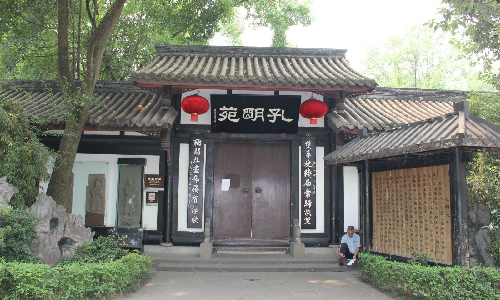
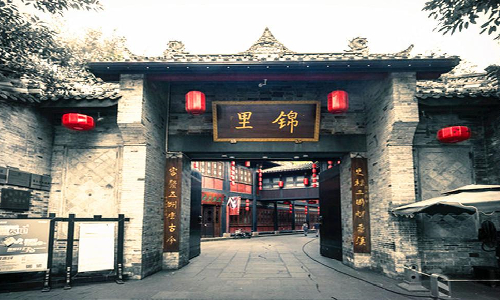
 Guilin
Guilin Today, you will take the estimated flight CA1948 12:00/15:00 to Guilin. Your local guide will meet you at the airport and transfer you to the hotel. Guilin, located in southern China, is a world-famous tourist city. With an area of 27,800 square kilometers, Guilin has a population of more than 4.9 million. Its name means “forest of sweet osmanthus” in Chinese, owing to the large number of fragrant sweet osmanthus trees located in the region. The city has long been renowned for its scenery of karst topography. You can also enjoy a nice food experience in Guilin by tasting local cuisines, such as Guilin rice noodles, beer fish, and bean paste rice.
The first stop in Guilin is the Elephant Trunk Hill. Its shape resembles a giant elephant sucking water from the river with its trunk, hence the name-Elephant Trunk Hill. At the top of the hill, there is the Samantabhadra Tower that was built in the Ming Dynasty. Seen from a distance, the tower looks like a sword on the elephant’s back.
Then we will drive southwest for about 200 kilometers to the Longji Rice Terrace and it will take about three hours. With a history of more than 2,300 years, these terraces are arranged in good order and look like ribbons. Owing to the spectacular scenery, lots of tourists come here and take pictures. There are three periods in a year that are really suitable for taking pictures here: from late May to mid-June, the middle of July, 5 days before and after the Mid-Autumn Festival (usually around the middle of September). Besides, it’s also a good time to take photos when it snows in winter.
After visiting, you will be driven to the city and have a rest in the hotel.
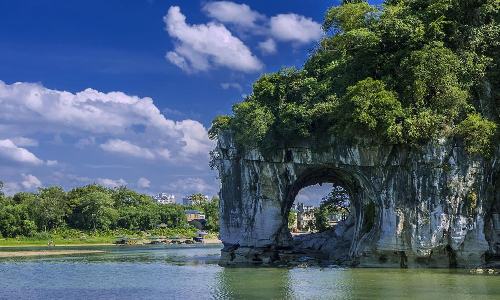

 Yangshuo
Yangshuo In the morning, you will take a Li River Cruise to Yangshuo. You will enjoy the landscape of the Li River and have lunch on the ship. There are two kinds of ships: three-star and four-star ones. The former provides Chinese box lunch and the latter serves Chinese buffet lunch. Normally, we will arrange a three-star cruise for you. If you want to choose the latter, please let us know.
After the Li River Cruise, our guide will take you to Yangshuo West Street. The street is nearly 800 meters long and about 8 meters wide. With a history of over 1,400 years, it is the oldest and most prosperous street in Yangshuo. The Yangshuo West Street was once the place where Sun Yat-sen gave lectures and where Xu Beihong (a modern Chinese painter) lived. Many famous foreign people have also been here, such as the former US president Clinton and Nixon; former Secretary of State Kissinger; former Prime Minister of U.K. Lady Thatcher.
Then you will be taken to the hotel in Yangshuo to have a rest. Hope you have had a good time today.

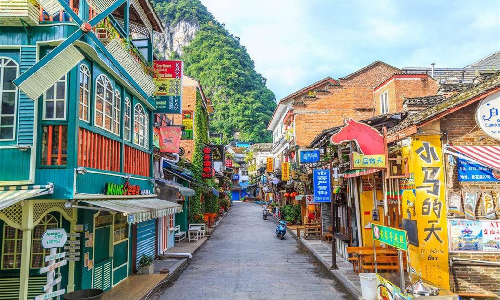
 Guilin
Guilin Shanghai
Shanghai Today we will drive northwest for more than one hour to Guilin, about 80 kilometers away from Yangshuo. Then you will be escorted to the airport for taking your flight MU8565 13:35/16:05 to Shanghai. Upon your arrival, you will be escorted to check in your downtown hotel.
Shanghai, one of the largest seaports in the world, is located in the Yangtze River Delta. It is a city that covers an area of 6,340.5 square kilometers and has a population of over 24 million. In Shanghai, you can not only appreciate Chinese classical gardens like Yu Garden, but also visit the Shanghai Tower and many other modern buildings. In addition, Shanghai is famous for serving various Chinese and international dishes, and its local cuisine is praised by visitors from home and abroad. Some local favorites include Shanghai steamed buns, fried dumplings, noodles mixed with scallion oil, and pork chop with rice cakes. So you will have a wonderful gastronomy tour in Shanghai. Do you look forward to it?
Today our guide will first take you to the Jade Buddha Temple. The temple was first built in the reign of Emperor Guangxu (1875-1908) and was used as a shrine of two statues brought by a monk named Huigen. In 1882, Huigen set out from Putuo Mountain alone and would like to follow the westward journey of Xuanzang (an eminent monk in the Tang Dynasty) to India-the holy land of Buddhism. He visited lots of Buddhist sites and passed Myanmar on his way home, where jade was abundant and the craftsmen were very skilled. With the donations of Chinese businessmen there, five jade Buddha statues were made and Huigen took them back home in 1899. When he arrived in Shanghai, he left two statues there at the request of local Buddhists and took the other three to Putuo Mountain.
Your next stop is Yu Garden (closed each Monday). It dates to the Ming Dynasty (1368-1644) and was owned by a government officer named Pan Yunduan. The pavilions, halls, rockeries, ponds and cloisters all have unique characteristics, which displays the garden art in the Ming and Qing Dynasties. There are 48 tourist spots in the garden, among which the Great Rockery is a spot you can’t miss. With a height of 12 meters, it’s the largest and oldest rockery in the southern region of the Yangtze River. On the top of the rockery, you can overlook the garden.
Later, you will go to Shanghai Old Street. It used to be an important area for foreign trade and internal commodity trade. Now, it is a business street that has a combination of tourist attractions, shops, entertainment, and cultural exhibits. If interested, you can also go to a tea house in the street and spend some leisure time.
In the afternoon, we will visit the Shanghai Tower, a megatall skyscraper in Shanghai. The tower covers an area of 578,000 square meters and its total height is 632 meters. As a complex super tall building, the tower is subdivided into five main functional areas: 24-hour offices; super five-star hotels and support facilities; high end retail shops; recreation zone; and conference facilities. The observation deck is on the 118th floor where you can have a panoramic view of Shanghai. For example, you can see the Oriental Pearl Tower and Shanghai Jinmao Tower in the near distance and overlook the Hongqiao Airport and the World Expo site. You will take an express lift to go up to the observation deck at a speed of 18 meters per second. It is currently the world’s fastest lift.
Then you will take an interesting visit to the Bund, standing by the bank of the Huangpu River. Its total length is 1.5 kilometers and there are 33 buildings on it. The HSBC Building built in 1923 is also located here and now is the location of Pudong Development Bank. Standing in front of the building, you can see three bronze gates and the bronze lions on both sides which were made by the British. It’s said that the bronze models of these lions were destroyed after they were completed, so the lions are precious. On the top of the lobby are eight mosaic murals depicting the architecture styles of eight cities in the early 20th century, including Shanghai, Hong Kong, London, Paris, New York, Tokyo, Bangkok, and Calcutta.
Your next stop is Nanjing Road, one of the top ten business centers in Shanghai. It is a paradise for shoppers at home and abroad. There are marble benches along the road so that people can have a rest on when they are tired. If you like collecting sneakers, don’t miss Nike Shanghai 001. Consumers can not only buy Nike products here, but also experience the innovative technology. As soon as you go upstairs to the third floor, you can see this cool large conveyor belt that displays numerous models of shoes. Besides, this place provides customized service and you can make your own Nike shoes.
Today your tour ends here, and our guide will take you to the hotel.


This morning you will take a cooking class and learn how to make Xiaolongbao (Chinese steamed buns) and other pastries. Xiaolongbao is a traditional Shanghai food and it’s mainly made of pork and flour. The class will take about 2-3 hours including lunchtime. At lunch, you can enjoy the delicious food made by yourself.
In the afternoon, we will go to the Former French Concession. It was the earliest, and gradually developed into the largest and most prosperous, French concession in China. In this area, there is a unique park in Shanghai that maintains the French classic style, Fuxing Park. Local people often play chess and exercise here. In the beautiful park, there are nice places like the Rockery Hill, Lotus Pond, Rose Garden, and Statue Square awaiting your visit.
Then you will go to Tianzifang Market where you can see creative shops, galleries, photo exhibitions, and various cafes. Among them, a pottery studio opened by Jamie (an American ceramist) attracts numerous foreign tourists to learn pottery skills. The unique feature of Tianzifang Market is that many local residents still live in the narrow lanes. You can even find the green letterbox decorated with the logo in the 1980s, which adds to the market an unexpected artistic beauty.
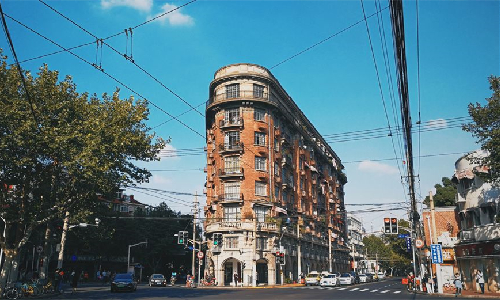
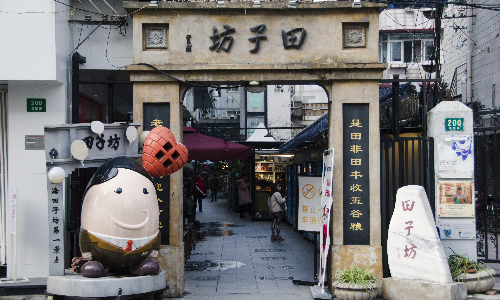
Your 15-days food tour in China will be over today and your guide will take you to the airport according to your flight schedule. We hope you are satisfied with our arrangements and look forward to serving you next time.
Author: He Simeng
Proofreader: Li Yiwen
| City | Five Star hotel list | Four Star hotel list |
|---|---|---|
| Beijing | Sunworld Dynasty Hotel Beijing Wangfujing | Sunworld Hotel Wangfujing |
| Xi'an | Tianyu Gloria Grand Hotel Xi'an | Sunworld Dynasty Hotel |
| Guilin | Lijiang Waterfall Hotel | Guilin Bravo Hotel |
| Yangshuo | Yangshuo Greenlotus Hotel | New Century Hotel |
| Chengdu | Sofitel Chengdu Taihe | Holiday Inn Express Chengdu Jinniu |
| Shanghai | Ocean Hotel Shanghai | Ambassador Hotel |
 |
![]() About your child or infant, please contact us for a discounted price.
About your child or infant, please contact us for a discounted price.



We started with a few days in Beijing & ended in Shanghai, from where we visited the Forbidden City and Great Wall. In between we visited Terra Cotta Warriors Museum, Panda Base, Shanghai Disneyland.

We had a wonderful holiday in China which will remain long in the memory. China is a breathtakingly beautiful country full of splendid temples and palaces, mountains and rivers, peaceful rural scenes and bustling shopping streets.
 QUICK ENQUIRY
QUICK ENQUIRY